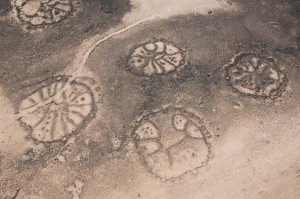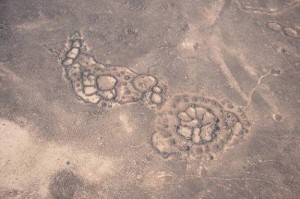 Enormous stone structures that can only be seen from the air, like Peru’s Nazca Lines, have been discovered in the desert lava fields of the Middle East. New satellite imagery and a program of aerial photography in Jordan have allowed archaeologists to locate thousands of these mysterious structures. They come in a variety of shapes, the most popular one being a spoked wheel, and can range in size from 82 feet to 230 feet.
Enormous stone structures that can only be seen from the air, like Peru’s Nazca Lines, have been discovered in the desert lava fields of the Middle East. New satellite imagery and a program of aerial photography in Jordan have allowed archaeologists to locate thousands of these mysterious structures. They come in a variety of shapes, the most popular one being a spoked wheel, and can range in size from 82 feet to 230 feet.
According to University of Western Australia professor David Kennedy, whose team has been involved in the aerial photography project documenting ancient structures in Jordan, there are more of these giant figures in Jordan alone than in all of Peru. They also cover more surface area and they are older.
Kennedy’s new research, which will be published in a forthcoming issue of the Journal of Archaeological Science, reveals that these wheels form part of a variety of stone landscapes. These include kites (stone structures used for funnelling and killing animals); pendants (lines of stone cairns that run from burials); and walls, mysterious structures that meander across the landscape for up to several hundred feet and have no apparent practical use.
The structures are remote and so difficult to see from the ground (even when you know they’re there), that thus far the wheels have not been excavated by archaeologists. That means we really don’t know how old they are. They look prehistoric but could be much more recent. Some wheels have been found on top of kites but never vice versa, so we know the kite shaped structures — which can be as much as 9,000 years old — predate the wheel shaped ones.
 Cairns have been discovered on some of the sites, so perhaps those locations used the giant stonework as part of a cemetery ritual. There’s so much variety, though, discoveries at one wheel can’t be generalized to draw conclusions about the structures as a group.
Cairns have been discovered on some of the sites, so perhaps those locations used the giant stonework as part of a cemetery ritual. There’s so much variety, though, discoveries at one wheel can’t be generalized to draw conclusions about the structures as a group.
Some of the wheels are found in isolation while others are clustered together. At one location, near the Azraq Oasis, hundreds of them can be found clustered into a dozen groups. “Some of these collections around Azraq are really quite remarkable,” Kennedy said.
In Saudi Arabia, Kennedy’s team has found wheel styles that are quite different: Some are rectangular and are not wheels at all; others are circular but contain two spokes forming a bar often aligned in the same direction that the sun rises and sets in the Middle East.
The ones in Jordan and Syria, on the other hand, have numerous spokes and do not seem to be aligned with any astronomical phenomena. “On looking at large numbers of these, over a number of years, I wasn’t struck by any pattern in the way in which the spokes were laid out,” Kennedy said.
You can browse a Flickrfull of pictures from the Jordan aerial photography program here.